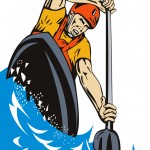Encountering a Shark While Kayaking
 Yes, believe it or not, even in something as big as a kayak, it is still possible to get bumped, chased, circled or even punctured by predators such as sharks. Although, it is not very often that this happens, you should be prepared for the possibility of a hostile situation or encounter with an uninvited predator. Kayaking is all about taking in and enjoying all that nature has to offer. Just make sure you know what to expect in these types of watery environments and how to be more prepared.
Yes, believe it or not, even in something as big as a kayak, it is still possible to get bumped, chased, circled or even punctured by predators such as sharks. Although, it is not very often that this happens, you should be prepared for the possibility of a hostile situation or encounter with an uninvited predator. Kayaking is all about taking in and enjoying all that nature has to offer. Just make sure you know what to expect in these types of watery environments and how to be more prepared.
There are 450 species of sharks that live all over the world, mostly in the ocean. The only one of these sharks can survive in fresh water. This is the bull shark. Bull sharks are thought to be the most dangerous type of shark in the world. This is due to the fact that they can reside in fresh or salt water and they usually stay in coastal waters that are less than 100 feet deep. The bull shark comes in at number three on the list of aggressive offenders. The other two sharks are the great white and the tiger shark. Tiger sharks come second to great whites because they do not have as many recorded attacks on humans. Tiger sharks, once a favorite for sport fishermen, are now a protected species.
It is known that humans are not a main food source for sharks. Although, we may not be first choice on their menu, if sharks are hungry, they will test out new food sources. This is our fault. Due to over-fishing or destruction of a shark’s main food source, they begin to look elsewhere. This is when shark attacks on humans occur and sharks head towards the surface and the beaches.
Are sit on top kayaks or sit inside kayaks more prone to attacks? There isn’t any data saying which one, if any, is more prone to attacks than the other. Although, a sit on top kayaker might be engaging in activities such as fishing or diving, that might spark interest in a nearby predator, a sit inside kayaker would have a harder time getting back in the kayak if they were to be capsized. Here are some steps you can take to avoid sharks.
1. Contact your local fish and game department. They will have information on seasonal behavior patterns, times of day and areas for increased shark population and any record of recent attacks in certain areas.
2. Stay away from fishermen and large groups of birds. A large group of birds will indicate a dead animal and fishermen might be chumming the waters. Both will attract sharks.
3. Anything that you wear that is shiny should be left at home. These things resemble fish scales and could attract a shark.
4. If you are paddling in areas that are known for sharks, be smart. Paddle in groups. If you have a dog with you, do not let it swim or splash. This could appear as prey to a nearby shark. Also, if you wish to take a swim off your kayak, avoid doing so at a river mouth or around a school of fish.
5. If you are fishing, keep your bait secured. Blood or chum in the water will attract a shark.
If you are paddling and see a shark, don’t panic. Most of the time, the shark has been attracted by something you are doing. If you are fishing and your bait bucket is over the side, let it go. If you have a fish on the line and a shark is following it, cut the line. Whatever you have done to attract the shark, do what you can to discourage it, and calmly paddle towards shore using smooth glides. Frantic splashing could further increase the shark’s curiosity.
If you encounter an aggressive shark, your paddle is your weapon. Start out by hitting him on the snout. If it comes back, go for the gill or its eye. You don’t want to start out hurting the shark, the snout bump just lets it know that you are not helpless.
If you are knocked out of your kayak, try to hold on to your paddle and get back in the kayak as quick as possible. Then, swiftly and smoothly paddle to shore. If you lose your paddle, swim to another kayak or to shore for safety. If you can’t get to shore, back up against something and limit the directions the shark can approach you. Don’t play dead. Bump his snout to let him know you will fight!
